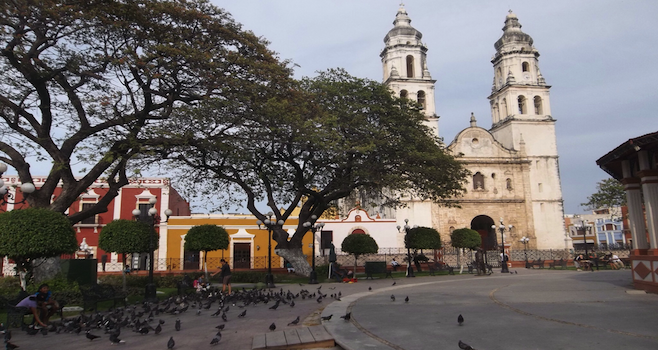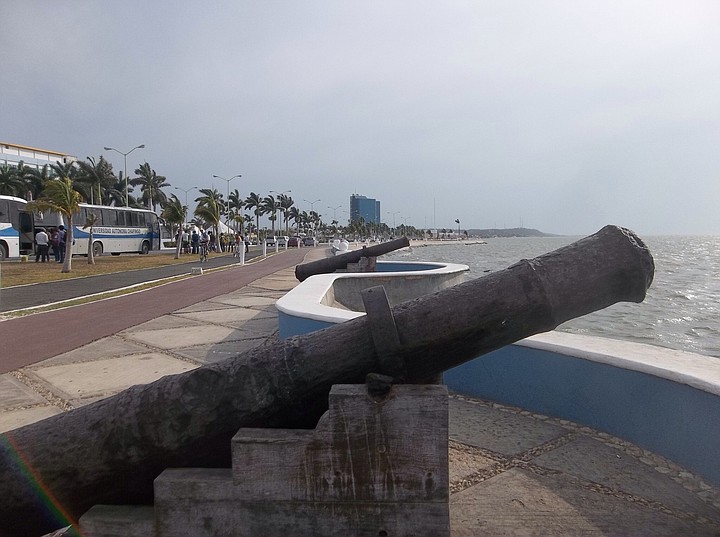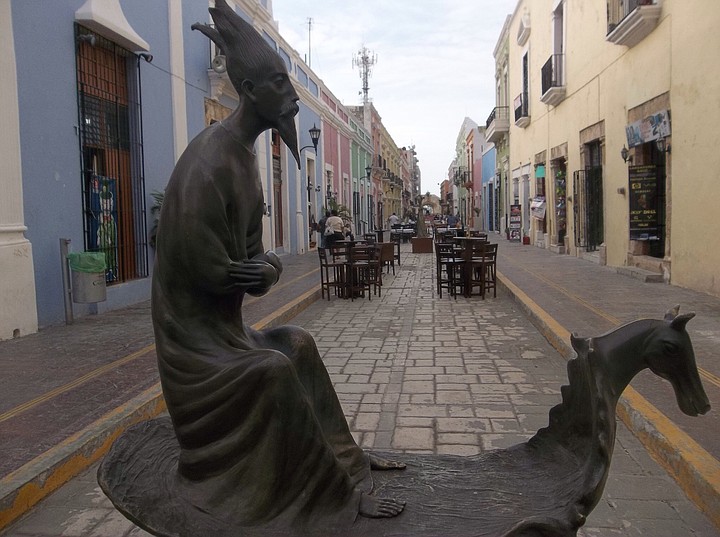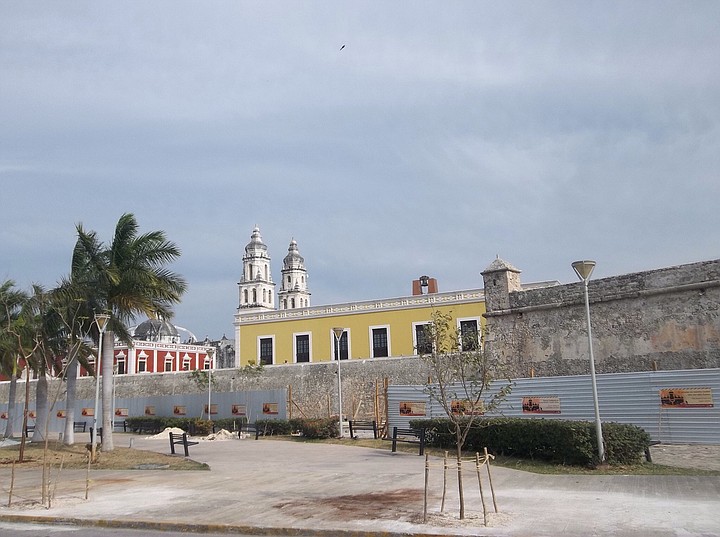 Facebook
Facebook
 X
X
 Instagram
Instagram
 TikTok
TikTok
 Youtube
Youtube

For those seeking an off-the-beaten-path alternative to Cancún and Mérida, Campeche is a captivating, underrated baroque colonial town on the west coast of the Yucatan peninsula. Capital of the state with the same name, it's located conveniently between Uxmal and Palenque for those journeying between these two great Maya sites.

Some of the best colonial architecture in Mexico can be found here. Campeche’s colonial charm and historical intrigue along with the vibrantly colored buildings in the old section of town underscore its status as a UNESCO World Heritage site. The scenic seaside walkway along the waterfront, the malecón, winds along the coast, providing a relaxing, romantic setting to soak in the sunset. Don’t let the cannons scare you – they’re reminders of the city’s heritage as a frequent target of pirates.
Though the buccaneers of the 17th century had Campeche squarely on their radar, the modern-day town has been generally ignored by tourists. Campeche has not catered to visitors in the way that Merida has with its English translations.
This is beginning to change, however. There's a growing, concerted movement to attract more tourists. As a result, more locals are becoming versed in English. Campeche still retains a friendly local feel, though, and those visiting here from Cancún might find the lack of resort crowds refreshing.
I journeyed here on a comfortable first-class ADO bus from Merida as a stopover on my way to Palenque. After arriving at my hotel, located on a narrow street in the old city lined with buildings painted in bright pastel colors, I couldn’t resist taking an immediate stroll. The plaza, an easy walk from virtually anywhere in town, is surrounded by various points of interest. These include the Campeche Cathedral (top) and Casa Seis, one of the first colonial homes in Campeche, now a cultural center.

Check out the wide variety of tropical sweets and fruits at various stands of the main market downtown. A few blocks from the plaza is the waterfront and malecón.
Campeche is a walker’s delight: museums, cafes and restaurants are all within a few blocks of the plaza. Street art and life-size bronze statues, including one of a local fisherman, dot the pedestrian walkways near the plaza. The town has a relaxed feel and, though there are fewer street performances here than in Merida, I happened upon an amazing series of musical performances and dances following a wedding. Sidewalks are being widened to create even more of a pedestrian-friendly zone.
No trip to Campeche is complete without a visit to the nearby Fort San Miguel, a reminder of the town’s turbulent history as a target of pirate raids.

Originally settled in 1517 by Spanish conquistadors in the Maya region An-Kin-Pech, Campeche became a frequent target of pirates in the 17th century due to its wealth and position as the most important seaport of the time along the Gulf of Mexico. Campeche’s citizens erected a defensive wall around the city (left) after a particularly bloody siege. The wall remains, and sections of it were being renovated during my visit.
Campeche can be easily reached by car or bus from Merida. If you're captivated and decide to stay for an extended period of time, there are other attractions worth exploring nearby. Outside of town, Hacienda Uayamon is one of the most unique restored mansions in the Yucatan.
Although this was a stopover for me on my journey to Palenque, more accessible Maya sites are worth exploring for those staying longer in Campeche. Edzna is a refreshing contrast to Chichen Itza because of its lack of vendors. Once a major Maya city around 200 AD., it offers climbable pyramids with spectacular views. Catch a colectivo from the Campeche market for a worthwhile day trip.
For those with ambitions of reaching an even more remote and grand site, the mysterious and secluded lost city of Calakmul is a few hours away by car or taxi. One of the largest Maya cities and a major rival of Tikal and Palenque, Calakmul features the tallest pyramid in the Yucatan peninsula. Visitors who have made the trek there often tout it as their favorite of all the Maya ruins. Hiring a guide is particularly recommended for this site. The Museum of Mayan Art at Fort San Miguel in Campeche contains some amazing jade masks that were found at the site.
Getting here is tricky if you don’t have a car. A pricey, but doable alternative is to rent a taxi for a day. The drive through the jungle provides opportunities for wildlife sightings, including monkeys and even jaguars. It takes about four hours, so it may be worthwhile to spend the night in the jungle near the ruins.
Campeche aims for a share of the tourist pie enjoyed by the Yucatan and resort-rich Quintana Roo. Visit here while it still retains its sleepy charm – before the world discovers this place – and it (yikes!) morphs into another Cancun.


For those seeking an off-the-beaten-path alternative to Cancún and Mérida, Campeche is a captivating, underrated baroque colonial town on the west coast of the Yucatan peninsula. Capital of the state with the same name, it's located conveniently between Uxmal and Palenque for those journeying between these two great Maya sites.

Some of the best colonial architecture in Mexico can be found here. Campeche’s colonial charm and historical intrigue along with the vibrantly colored buildings in the old section of town underscore its status as a UNESCO World Heritage site. The scenic seaside walkway along the waterfront, the malecón, winds along the coast, providing a relaxing, romantic setting to soak in the sunset. Don’t let the cannons scare you – they’re reminders of the city’s heritage as a frequent target of pirates.
Though the buccaneers of the 17th century had Campeche squarely on their radar, the modern-day town has been generally ignored by tourists. Campeche has not catered to visitors in the way that Merida has with its English translations.
This is beginning to change, however. There's a growing, concerted movement to attract more tourists. As a result, more locals are becoming versed in English. Campeche still retains a friendly local feel, though, and those visiting here from Cancún might find the lack of resort crowds refreshing.
I journeyed here on a comfortable first-class ADO bus from Merida as a stopover on my way to Palenque. After arriving at my hotel, located on a narrow street in the old city lined with buildings painted in bright pastel colors, I couldn’t resist taking an immediate stroll. The plaza, an easy walk from virtually anywhere in town, is surrounded by various points of interest. These include the Campeche Cathedral (top) and Casa Seis, one of the first colonial homes in Campeche, now a cultural center.

Check out the wide variety of tropical sweets and fruits at various stands of the main market downtown. A few blocks from the plaza is the waterfront and malecón.
Campeche is a walker’s delight: museums, cafes and restaurants are all within a few blocks of the plaza. Street art and life-size bronze statues, including one of a local fisherman, dot the pedestrian walkways near the plaza. The town has a relaxed feel and, though there are fewer street performances here than in Merida, I happened upon an amazing series of musical performances and dances following a wedding. Sidewalks are being widened to create even more of a pedestrian-friendly zone.
No trip to Campeche is complete without a visit to the nearby Fort San Miguel, a reminder of the town’s turbulent history as a target of pirate raids.

Originally settled in 1517 by Spanish conquistadors in the Maya region An-Kin-Pech, Campeche became a frequent target of pirates in the 17th century due to its wealth and position as the most important seaport of the time along the Gulf of Mexico. Campeche’s citizens erected a defensive wall around the city (left) after a particularly bloody siege. The wall remains, and sections of it were being renovated during my visit.
Campeche can be easily reached by car or bus from Merida. If you're captivated and decide to stay for an extended period of time, there are other attractions worth exploring nearby. Outside of town, Hacienda Uayamon is one of the most unique restored mansions in the Yucatan.
Although this was a stopover for me on my journey to Palenque, more accessible Maya sites are worth exploring for those staying longer in Campeche. Edzna is a refreshing contrast to Chichen Itza because of its lack of vendors. Once a major Maya city around 200 AD., it offers climbable pyramids with spectacular views. Catch a colectivo from the Campeche market for a worthwhile day trip.
For those with ambitions of reaching an even more remote and grand site, the mysterious and secluded lost city of Calakmul is a few hours away by car or taxi. One of the largest Maya cities and a major rival of Tikal and Palenque, Calakmul features the tallest pyramid in the Yucatan peninsula. Visitors who have made the trek there often tout it as their favorite of all the Maya ruins. Hiring a guide is particularly recommended for this site. The Museum of Mayan Art at Fort San Miguel in Campeche contains some amazing jade masks that were found at the site.
Getting here is tricky if you don’t have a car. A pricey, but doable alternative is to rent a taxi for a day. The drive through the jungle provides opportunities for wildlife sightings, including monkeys and even jaguars. It takes about four hours, so it may be worthwhile to spend the night in the jungle near the ruins.
Campeche aims for a share of the tourist pie enjoyed by the Yucatan and resort-rich Quintana Roo. Visit here while it still retains its sleepy charm – before the world discovers this place – and it (yikes!) morphs into another Cancun.
Comments